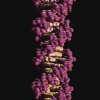Archive for September, 2009

Sleep Science
Sep 30th
Have you ever wished there were more hours in the day? I know someone who insists on extending his days by consuming energy drinks. In his opinion, sleeping is a waste of precious time. Unfortunately, for most humans, 8 hours of sleep is required to function properly. Some people can manage with far less sleep, which for those of us who really NEED 8 hours of shut-eye, is hard to imagine. For me, sometimes it seems even 8 hours doesn’t suffice, which is evidenced by my morning alarm-snooze-alarm-snooze routine, and my sofa sleeping habit in the evenings.
In an August article More >

Shouldn’t you be a girl? The male calico cat syndrome
Sep 28th
For all the cat lovers out there, cats come in many colors. Two basic pigments to be discussed here are orange and black. There is one curious, rule for cats with patches of orange and black; they are all supposed to be female. The genetics behind this fact is as interesting as the phenomenon itself.
Chromosomes are passed from parent to child. For many animals, including us, the X and Y chromosomes determine gender. For most mammals, the presence of two X chromosomes indicates a female, while the presence of one X and one Y chromosome indicates a male. For a More >

Medicine or Poison? It’s in Your Genes, duh…
Sep 24th
As the ongoing deciphering of the human genome provides us with more and more insights about our predisposition for diseases and genetic disorders, (see Your Genes Your Health for examples) I am equally, if not more astounded by what it tells us about our ability to utilize medicines to counteract diseases.
Just recently, a group of researchers at the University of Maryland School of Medicine have identified a variant of a gene that is believed to play a major role in determining why people do not respond to a popular anti-clotting medication. This gene variant, carried by as many as a third More >

Twin Studies
Sep 24th
Eugenicists studied twins to explore genetic and environmental influences on human behavior. Twins, some raised separate from one another, were tested intellectually and measured physically. Eugenicists were looking to prove that heredity determines everything about an individual. They examined fingerprints, hair and eye color, temperament, memory, measured every body part, and even asked subjects how they liked their eggs and steak prepared.
The Archive includes several images from twin studies performed by Otmar Freiherr von Verschuer at the Institute of Hereditary Biology and Race Biology at the University of Frankfurt. These studies were horrifically taken to an extreme by the Nazis in More >

Smart Drugs and Should We Take Them
Sep 21st
I was looking back through the ADHD section of G2C Online this week, namely the interview with Philip Shaw on ADHD and medication. According to Dr. Shaw, up to 90% of children with ADHD who take Ritalin, Adderall or Strattera show improvements on cognitive tasks . This is quite an impressive statistic and got me wondering whether these drugs enhance normal cognitive functions and, if so, are people taking them? The answer to both these questions seems to be a firm “yes”.
In April 2008, Nature published results of an informal online survey of readers’ use of cognition-enhancing drugs, namely Ritalin, Provigil, and More >

It’s All Your Parents’ Fault
Sep 15th
Eugenicists looked at a diversity of “traits” and asserted that many of them were genetically inherited, excluding any other cause. The subjects of the studies often came from unique populations, including circus performers, residents in mental institutions, and even historical figures, long deceased.
A quick search in the Eugenics Archive reveals some of the traits studied by Eugenicists:
Civic leadership Musical ability Dressmaking Epilepsy Dwarfism Giantism Carpentry Deafness Eye color Insanity Longevity Shiftlessness Cancer Blindness Albinism Hemophilia Boat building Degeneracy Poverty Feeblemindedness Cleft palate Hare lip Manic depression Hair color, texture Polydactyly Height Literary ability Inventiveness Color blindness Mechanical skill Artistic ability More >

A Complication Of Sickle Cell
Sep 12th
This blog serves to provide information about a common complication of sickle cell disease known as pulminary hypertension. Puluminary hypertension is a disorder in which one has elevated pulminary artery pressure and pulminary vascular resistance. Pulminary hypertension turns out to be a rising risk factor for morbidity and mortality in adults with sickle cell disease. As in other chronic haemolytic disorders an echocardiograph is very helpful in elucidating pulminary hypertension. Any insight into the disposition of the patient can decrease the progression of the disease early on. Therapy for these patients may consist of vasodilators and or antiremodiling agents depending More >

Passing on Genes and Traits
Sep 9th
Why do you look the way you do? There are many ways to answer this question, but essentially it all comes down to the information in your DNA and the proteins your cells make. Your DNA contains genes that code for proteins. Different proteins have different functions, each contributing to your various traits and functions.
Why do we often see similar traits among parents and offspring? We inherit our DNA from our mother and father. This means we have half of our genes, or recipes, from our mom and half from our dad. Even with this basic idea, it can be More >

Chikafrogonewtasaurus
Sep 4th
Being an educator at the DNALC does not mean that everything has to be all “DNA”! Sometimes, it’s all about proteins. My background is in ecology and evolution, with a particular bent towards dinosaurs. In 2005, dinosaur paleontologists decided to slice the leg bone of a 68 million year old Tyrannosaurus rex, just to see what it looked like inside. They were in for a surprise. There were remnants of soft tissue – still present after 68 million years!!
In 2007, they were able to identify and compare seven protein sequences. Three of these proteins seemed to be closely related to chickens. More >

Teaching Genetics: Simplicity for Success
Sep 2nd
I love to talk about the biology behind how life works with other people. Some of the best conversations I have ever had have been with fifth graders learning about DNA. I am amazed that they know an incredible amount of information relating to genetics, way more than I ever knew when I was their age.
I currently teach genetics and molecular biology to middle school students, high school students, teachers, and the general public. One of the greatest skills I have learned in my current position is the importance of engaging your audience and making the material you are introducing More >
